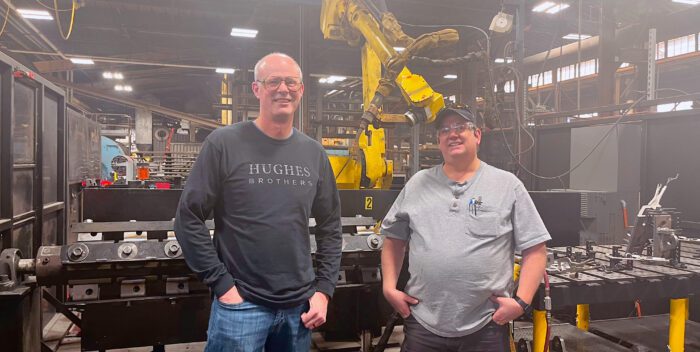Hughes Brothers automates process, increases efficiency, and values employees as family
President of the Hughes Brothers John Hughes (left) and automation specialist Bill Brauer (right) stand in front of a Fanuc robot, which is one of the current robots in the company.
Photo credit: Bailey Mooney
By Bailey Mooney
Recent advancements in automation at Hughes Brothers, Inc. in Seward provide an increase of competitive advantage, while also improving production speed and employee safety throughout the company.
Hughes Brothers is a vital supplier for the utility industry with products that affect communities nationwide. The company is a leader in the electric transmission and distribution industry and manufactures products that are made from wood, steel, and fiberglass. Although technology has changed the process of making products, Hughes Brothers maintains the company’s drive to produce quality products for communities all over the United States.
Hughes Brothers engineers steel and wood framing for consumers all over the United States, while making various products for the electric utility industry. It makes about 100,000 different end products using about 900,000 small pieces and parts. Although Hughes Brothers does not make poles or conductors, they design nearly all the other electrical pole products. These products can range from the cross arms to the pole line hardware that is designed to withstand varying weather conditions.
Hughes Brothers strives to make each product one of high caliber despite the large quantity of parts the company produces. Owner John Hughes said that the company developed a mission statement before mission statements for companies grew in popularity.
“We have had a mission statement since before such things were popular. It is to produce a quality product, ship it on time, at a fair price,” Hughes said. “You do those three things; everything else takes care of itself.”
Hughes Brothers has succeeded with this mission statement for over 100 years, which has allowed the company to create new possibilities for advancement. One of the most recent technological advances is the construction of a new building on the north side of the campus. The building is 350 feet by 200 feet and will house robotic technology new to Hughes Brothers.
Hughes Brothers first started using welding robots in 1999 with a Yaskawa Motoman welding robot. The company previously had a spot welder purchased in the 1940s, which utilized a lot of energy and was water-cooled. The spot welder eventually stopped working, and because of the amount of energy the machine was using, the company decided not to fix it, replacing it with the Yaskawa Motoman welding robot. The new robotic welder used 30 amps for welding; however, the spot welder used 400 amps.
“Not only did the welding robot save Hughes Brothers tons in electrical energy, but it also made the parts quicker and helped the process be easier for the operators with quite a few less quality defects in the manufacturing phase,” said Matt Stryson, vice president of process facility engineering.
Hughes Brothers was built off of the willpower of four brothers who originally built houses. They pivoted to the electric utility industry when a storm ripped through Seward Country in 1921.
The company now has opportunities for employees that seemed infeasible in the past. Hughes Brothers says the average number of years an employee works there is around 15. For some, working there has become a valuable family tradition dating back many years.
“I have been with Hughes Brothers for 46 years,” said Norman Klein, Welding Department foreman. “My father also worked here as well as my siblings. Hughes Brothers continuously showed me the importance of being loyal to the company, as well as how to make quality products to help a number of customers nationwide.”
After using the welding robot, Klein realized that it would be great to make fixtures and try to make shear blocks for heavy-duty pole bands. Shear blocks are used to properly transfer energy throughout the pole. A pole band is the hardware that consists of two or more pieces of steel bands that make sure the pole is always fastened to support the pole line connection.
Klein went on to work with the company’s Tool and Die shop to find a quicker route to making that large quantity item. After some research and development, the parts started coming out better. The robot needed occasional adjustments in the programs. Since it was purchased through Linweld in Waverly, Nebraska, if Klein needed any help with programming, backups or preventive maintenance, it was accessible about 30 minutes away.
“Matt Stryson and I had received training on the welding robot to learn how to program it. So, we started to feel more confident trying new things with the robot,” he said. “That was when we realized that we could weld shear blocks for heavy-duty pole bands. This is important because it was a large quantity item for the welding department.”
However, when a tsunami hit Motomas’s chip plant in Japan, backup printed circuit boards and parts became unavailable. When it came time to switch to a different model of welding robots, the company decided to go with the Airgas company out of Omaha and Lincoln Electric’s joint venture with Fanuc robots.
Automation has played a significant role in the advancement of the company over several years.
When Klein started in the welding department, the company had about six to eight employees, but now it has more than 30. By using new welding robots, employees have become much more productive, and their jobs have become much cleaner. The sales department also has been able to quote more competitive prices to customers.
Automation is defined as any technology that does work while reducing human effort. When automation is discussed, it means software and hardware work together. This combination is capable of doing work in many different industries. In the case of Hughes Brothers, the robots should ideally repeat the same movement every time as long as the parts utilized are consistent and error-free. This, in turn, helps with product quality and overall efficiency. This efficiency helps control the number of parts produced in an hour.
A part that is currently being manufactured by the robot systems at Hughes Brothers is welded washer nuts that come in four different sizes. The robots also help weld together metal shear blocks that are a part of the pole band assembly, which come in three different sizes.
The way that robots contribute to this process is the operator first loads the fixture with parts to be welded together, and then the robot welds them together automatically. The robot is able to do this because of the program it has for that particular part.
Hughes Brothers continues to work on developing new fixtures that will allow the company to weld more products using the robots. Part of learning what robots can do is the hands-on process of working with them, as well as personalized training.
“My hands-on experience working with robots in the welding department has provided me with interest about the advancement in technology and what the robots will be able to achieve in quality consistency,” said Klein.
The machines new to Hughes Brothers will help speed up the manufacturing process by cutting, and putting holes in tubes, angle iron and plates. These machines will accelerate the process of making parts like rectangle and square tubing, which help power lines connect to the power stations of a utility pole by supporting cables or wires. Because Hughes Brothers does not make utility poles, the client has to bolt them on the pole upon purchase.
Leveraging automation aids companies in being more precise and accurate while working with many things at once. Robots not only help companies reduce human effort but also allow them to work with multiple products at once over a shorter period of time.
Hughes Brothers will leverage automation by implementing three new Voortman Machines into the workflow. These machines include V807, a robotic plasma processing machine; V320, a plate processing machine; and V550-7, a flat angle machine.
Demonstration videos about how the machines work can be found on the Voortman website. The plasma machine has a fume collector, so operators don’t have to breathe in the welding or plasma smoke.
The role these new robots will play ultimately will be decided when they arrive. However, each machine can fabricate hundreds of parts for the company while being safer for employees.
“These machines are a lot environmentally cleaner and safer for the operators,” said Stryson.
In addition to automation contributing to environmental safety, and speeding up production, it also keeps companies competitive. Hughes Brothers has chosen to increase the automation behind their production process to keep up with other companies producing a similar product.
Companies similar to Hughes Brothers also have been using equipment like this because it allows their employees to make supplies faster and safer. Incorporating each new machine into Hughes Brothers will cost the company over $1 million, and the building is estimated to cost around $10 million.
“This is by far the largest project that this company has ever done, by a long way,” said Stryson, who has been with the company for 40 years.
“When I first started here, if we had a project that was worth $30,000, that was viewed as really high. The company has really grown,” he said. “When I started here about 40 years ago, we sold about $15 million worth of merchandise a year; now, we sell about $130 million worth of merchandise yearly, with about the same amount of employees.”
Worldwide, about 2.7 million robots are used in factories, The International Federation of Robotics said in 2020. These robots are capable of performing a wide variety of tasks that can include welding, material handling and assembly.
Investments in robot automation continue worldwide, and the United States is third in the world for installing industrial robots. This leaves many people asking: are we giving robots our jobs? The answer is true in some situations, but the overwhelming answer is no. Robots can perform risky work that has been a detriment to humans in the past, but they also leave their handlers with increased proficiency and energy when they return home to their families.
“By utilizing robots, we have helped our welding department employees be much more productive; their jobs are cleaner and more ergonomic, and our sales department has been able to quote more competitive prices for merchandise,” said Stryson.
Younger employees moving into various jobs have been utilizing technology for years to make their lives easier. They are attracted to automation and look for ways to use it for tasks they may not want to do themselves.
For companies like Hughes Brothers to stay competitive, they must continue to make strides in automation, which helps keep good jobs in the community, as well as attracting a new generation of workers.
“Technology will allow the company to stay competitive, which will keep their doors open, keeping good jobs in the community,” said Bill Brauer, the automation specialist at Hughes Brothers. “Technology will also attract the next generation of workers that will stay in the community instead of going elsewhere.”
Robotic cells are a highlight of automation solutions and can provide quicker routes to assembly, welding and inspection compared with traditional automated machines. Robots and robot cells have not evolved drastically in decades, but the other technologies that can be added to give them more abilities have improved considerably.
The sensors are better and cheaper than they have been in previous eras of automation. The automation at Hughes Brothers does a variety of things for the company but three of the most valuable aspects are efficiency, quality, and safety.
Efficiency helps products to be produced at a cheaper rate, while also allowing customer delivery times to be met at a faster rate. The quality reduces rework costs, keeps the overarching costs low and customers happy. Safety makes employees happier and removes the cost of injuries.
The new technologies implemented at Hughes Brothers give the ability of sight to automation. The improvement of sensing technology software can lead to better results. Artificial intelligence software can focus on the part using digital cameras to create a program for welding a part. Some machines at Hughes Brothers have electrical eyes that are used to line up a plate properly.
“New technologies will allow companies like Hughes Brothers, which have a large variety of parts and large quantity orders, to take more advantage of technology where it was thought to be infeasible in the past,” said Brauer.
An important aspect will be reducing the time related to the production process for large-quantity orders. Customers won’t have to wait six months for their orders to ship. The aim is to get the time down to around two months.
Much of the work done in factories like Hughes Brothers requires a multiplicity of skills. Automating some of these skills does not make other skills unnecessary; it makes them more important.
Employees of the future will help verify the product is being produced correctly, as well as get the next items ready to run. Hughes Brothers also hopes that employees will be diligent in correcting items that may need it.
“Correcting items that need it will help increase employee’s skills and knowledge, rather than just operating one machine, they may be tending up to 10,” said Brauer.
Although certain job responsibilities have shifted slightly through automation, the United States has added around 14 million jobs since the 2020 recession, according to the White House website. The United States’ ability to recover from the recession is particularly striking compared with past recoveries.
For example, in the recovery from the Great Recession in the late 2000s, it took more than five and a half years for the maximum unemployment rate to return to its pre-recession level of 7.2 percent. Following the COVID-19 recession, the U.S. took less than two years for the maximum unemployment rate to recover to the pre-recession level. In April 2020, Seward County’s unemployment rate peaked at 7.6 percent, however, in December 2023, it was down to 2.1 percent.
Hughes Brothers continued to operate throughout the coronavirus pandemic. It was determined that the company was an essential business, and it was necessary to remain open.
The U.S. Department of Homeland Security defines essential workers as those whose operations and services that are typically essential to continue critical infrastructure operations. While many people were at home during the pandemic, Hughes Brothers employees continued to go to work, supporting the country by providing products necessary to keep electricity available in many areas.
The Human Resources Department at Hughes Brothers worked closely with outside firms to help sanitize restrooms and other danger zones. “Sometimes these companies even sanitized while we were here,” said Stryson.
Companies like Hughes Brothers have been indispensable in the United States, which leads concerned community members to consider the challenge of automation and how it relates to them.
The challenge is how to ethically balance the scope of what is possible with companies need to stay competitive. Improvements in any one link in the chain help increase the value of improving other links. Technological posterity is decided by a wide variety of consumers, employees and the institution itself.
“If a business is going to stay relevant with competitors, the business has to keep up with the competition. So you have to attract the best employees, and to do that, the employees have to see that the owners are investing back in the company,” said Stryson.
According to the Bureau of Labor Statistics, manufacturing continues to be among the top five employment sectors in the United States. Manufacturing jobs make up 12.5 percent of Nebraska’s employment. The employment rate for manufacturing jobs continues to rise. There has been a 7.1 percent growth in manufacturing jobs in Nebraska since 2020.
Hughes Brothers said employee numbers will remain the same, even with new technology. The company does not expect a reduction or increase in their employee count. The company website shows it currently employs 297 people, and as new jobs arise from expansion, or the retirement of previous employees, additional applicants will be sought. Hughes Brothers encourages new applicants to check back with the company to see if new positions are available.
For some employees, one of the most important highlights of working for Hughes Brothers is the community of people that work there. The company attracts people that want to work safely as well as contribute to its overall success and value. This in turn makes the work environment a special place for camaraderie.
“Our strength as a company lies with the truly excellent employees we have working here,” said Kevin Beck, environmental manager and leader of the safety team. “By working safely, employees contribute to the company’s success, which, in turn, makes the employee successful.”
As automation tools improve, technology maximizes leverage and increases the necessity for expertise, judgment and creativity. No matter how well a machine is guarded, the human factor plays a significant role in safety. Attentive work is still a priority; technology has yet to filter out that factor.
“Safety is prioritized every day. The goal is for employees to leave work the same as when they started work,” Beck said. “New technologies are always good and positive but don’t always account for the human factor.”
Alongside prioritizing employee safety, Hughes Brothers aspires to be a good steward of the environment. Local, state and federal government agencies provide an array of laws, regulations and best management practices for implementing environmental safety. There are legal ramifications if companies attempt to cut corners or fail to follow government rules.
“As a company, we strive to do the ‘right thing’. If we do the right thing, environmental ethics takes care of itself,” Beck said. “We are responsible to the city, the neighborhood, and our employees to do the right thing. Hughes Brothers has a great reputation as a company that treats its employees well, manufactures a quality product, and is a good steward of the environment.”
Although employees at Hughes Brothers take pride in the company’s prioritization of environmental ethics, they also appreciate the owners’ overarching attitude on a variety of topics. Stryson said the owners treat employees the way that they would want to be treated, creating a positive and safe work environment.
“The owners of Hughes Brothers, Ted, John, and Tim are really good guys,” Stryson said. “They emphasize that they want to have a nice place to work and recruit good people. And also treat people how they want to be treated.”
Advancements in companies leveraging automation are not solely based on automation. It’s also because of people. When companies leverage technology, value is found when people and automated systems work together. The reduction in effort that automation brings is part of how the company helps employees produce their best work.
“It’s not just the job that is the satisfaction, but it is the whole package; there are so many factors to having a balanced life,” said Stryson. “I consider many people here to be a part of my family; I am with them more than I am with my family. I really like the people here.”






















